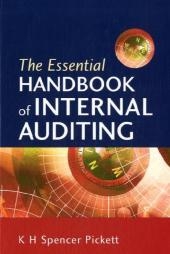
The Essential Handbook of Internal Auditing
John Wiley & Sons Ltd (Verlag)
978-0-470-01316-8 (ISBN)
- Titel gebraucht verfügbar
- Artikel merken
K.H. Spencer Pickett is a course director at CPMS, in Ascot, Berkshire, where he is responsible for training programmes on internal audit, corporate governance and risk management. Spencer is a member of the Chartered Association of Certified Accountants, Institute of Internal Auditors, Certified Fraud Examiners and Chartered Institute of Personnel and Development.
List of abbreviations. 1 Introduction. Introduction. 1.1 Reasoning behind the Book. 1.2 The IIA Standards and Links to the Book. 1.3 How to Navigate around the Book. 1.4 The Handbook as a Development Tool. 1.5 The Development of Internal Auditing. Summary and Conclusions. Chapter 1: Multi-Choice Questions. References. 2 Corporate Governance Perspectives. Introduction. 2.1 The Agency Concept. 2.2 Corporate Ethics and Accountability. 2.3 International Scandals and their Impact. 2.4 Models of Corporate Governance. 2.5 Putting Governance into Practice. 2.6 The External Audit. 2.7 The Audit Committee. 2.8 Internal Audit. 2.9 The Link to Risk Management and Internal Control. 2.10 Reporting on Internal Controls. Summary and Conclusions. Chapter 2: Multi-Choice Questions. References. 3 Managing Risk. Introduction. 3.1 What is Risk? 3.2 The Risk Challenge. 3.3 Risk Management and Residual Risk. 3.4 Mitigation through Controls. 3.5 Risk Registers and Appetites. 3.6 The Risk Policy. 3.7 Enterprise-Wide Risk Management. 3.8 Control Self-Assessment. 3.9 Embedded Risk Management. 3.10 The Internal Audit Role in Risk Management. Summary and Conclusions. Chapter 3: Multi-Choice Questions. References. 4 Internal Controls. Introduction. 4.1 Why Controls? 4.2 Control Framework-COSO. 4.3 Control Framework-CoCo. 4.4 Other Control Models. 4.5 Links to Risk Management. 4.6 Control Mechanisms. 4.7 Importance of Procedures. 4.8 Integrating Controls. 4.9 The Fallacy of Perfection. 4.10 Internal Control Awareness Training. Summary and Conclusions. Chapter 4: Multi-Choice Questions. References. 5 The Internal Audit Role. Introduction. 5.1 Why Auditing? 5.2 Defining Internal Audit. 5.3 The Audit Charter. 5.4 Audit Services. 5.5 Independence. 5.6 Audit Ethics. 5.7 Police Officer versus Consultant. 5.8 Managing Expectations through Web Design. 5.9 Audit Competencies. 5.10 Training and Development. Summary and Conclusions. Chapter 5: Multi-Choice Questions. Reference. 6 Professionalism. Introduction. 6.1 Audit Professionalism. 6.2 Internal Auditing Standards. 6.3 Due Professional Care. 6.4 Professional Consulting Services. 6.5 The Quality Concept. 6.6 Defining the Client. 6.7 Internal Review and External Review. 6.8 Marketing the Audit Role. 6.9 Audit Feedback Questionnaire. 6.10 Continuous Improvement. Summary and Conclusions. Chapter 6: Multi-Choice Questions. References. 7 The Audit Approach. Introduction. 7.1 The Systems Approach. 7.2 Control Risk Self-Assessment (CRSA). 7.3 Facilitation Skills. 7.4 Integrating Self-Assessment and Audit. 7.5 Fraud Investigations. 7.6 Information Systems Auditing. 7.7 The Consulting Approach. 7.8 Compliance. 7.9 Value for Money. 7.10 The 'Right' Structure. Summary and Conclusions. Chapter 7: Multi-Choice Questions. References. 8 Setting an Audit Strategy. Introduction. 8.1 Risk-Based Strategic Planning. 8.2 Resourcing the Strategy. 8.3 Managing Performance. 8.4 Dealing with Typical Problems. 8.5 The Audit Manual. 8.6 Delegating Audit Work. 8.7 Audit Information Systems. 8.8 Establishing a New Internal Audit Shop. 8.9 The Outsourcing Approach. 8.10 The Audit Planning Process. Summary and Conclusions. Chapter 8: Multi-Choice Questions. References. 9 Audit Field Work. Introduction. 9.1 Planning the Audit. 9.2 Interviewing Skills. 9.3 Ascertaining the System. 9.4 Evaluation. 9.5 Testing Strategies. 9.6 Evidence and Working Papers. 9.7 Statistical Sampling. 9.8 Reporting Results of the Audit. 9.9 Audit Committee Reporting. 9.10 A Risk-Based Audit Approach (RaCE). Summary and Conclusions. Chapter 9: Multi-Choice Questions. References. 10 Meeting the challenge. Introduction. 10.1 The New Dimensions of Internal Auditing. 10.2 Globalization. 10.3 The Changing Auditor. 10.4 Meeting the Challenge. 10.5 Ten Little Maxims. Summary and Conclusions. Chapter Ten: Multi-Choice Questions. References. Appendix A: Suggested Answers. Appendix B: Candidate's Answers. Index.
| Erscheint lt. Verlag | 15.4.2005 |
|---|---|
| Zusatzinfo | Illustrations |
| Verlagsort | Chichester |
| Sprache | englisch |
| Maße | 169 x 243 mm |
| Gewicht | 524 g |
| Einbandart | Paperback |
| Themenwelt | Wirtschaft ► Betriebswirtschaft / Management ► Rechnungswesen / Bilanzen |
| ISBN-10 | 0-470-01316-8 / 0470013168 |
| ISBN-13 | 978-0-470-01316-8 / 9780470013168 |
| Zustand | Neuware |
| Haben Sie eine Frage zum Produkt? |
aus dem Bereich



